Abstract
1. The effect of graded increases in inspiratory airflow resistance on the electrical activity and the mechanical behaviour of the three groups of inspiratory intercostal muscles (parasternal intercostal, external intercostal, levator costae) situated in the cranial portion of the rib-cage has been studied in ten anaesthetized, spontaneously breathing dogs. The mechanical behaviour of the muscles was determined by measuring the respiratory changes in muscle length and the displacements of the rib. 2. During unloaded inspiration, the three muscles were active, the rib moved in the cranial direction, and the parasternal intercostal and levator costae muscles shortened; in most animals, the external intercostals shortened as well. 3. Graded increases in inspiratory airflow resistance elicited a progressive inhibition of parasternal intercostal activity and a gradual facilitation of external intercostal and levator costae activities. Concomitantly, the parasternal intercostals continued to shorten during inspiration. However, both the external intercostals and the levator costae progressively lengthened, and the rib was gradually displaced in the caudal direction. This pattern persisted after increases in chemical respiratory drive had developed. 4. Sectioning the phrenic nerve roots did not alter the electrical or the mechanical response of the parasternal intercostal muscles to loading, but it markedly affected the response of the external intercostals and levator costae. After phrenicotomy, the external intercostals and levator costae continued to shorten during loaded breaths, the rib continued to be displaced in the cranial direction, and although the rate of inspiratory muscle shortening and of rib motion decreased, the facilitation of external intercostal and levator costae activities was markedly reduced or abolished. 5. Lengthening of the external intercostals and caudal displacement of the rib was reproduced by isolated stimulation of the phrenic nerves. 6. The reflex facilitation of external intercostal and levator costae activities that takes place during inspiratory resistive loading thus results primarily from the collapsing action of the diaphragm on the cranial portion of the rib-cage and the consequent lengthening of these muscles. The mechanical effectiveness of this reflex facilitation, however, appears to be relatively small.
Full text
PDF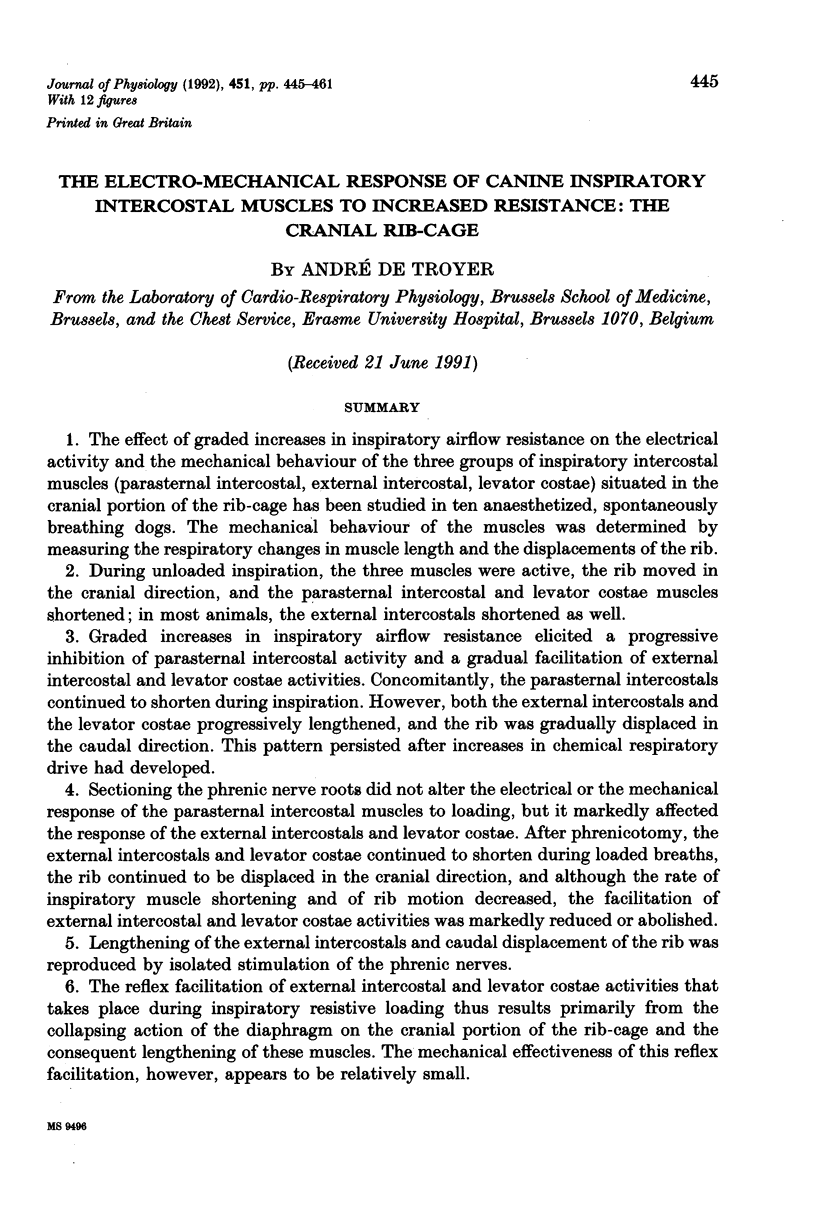



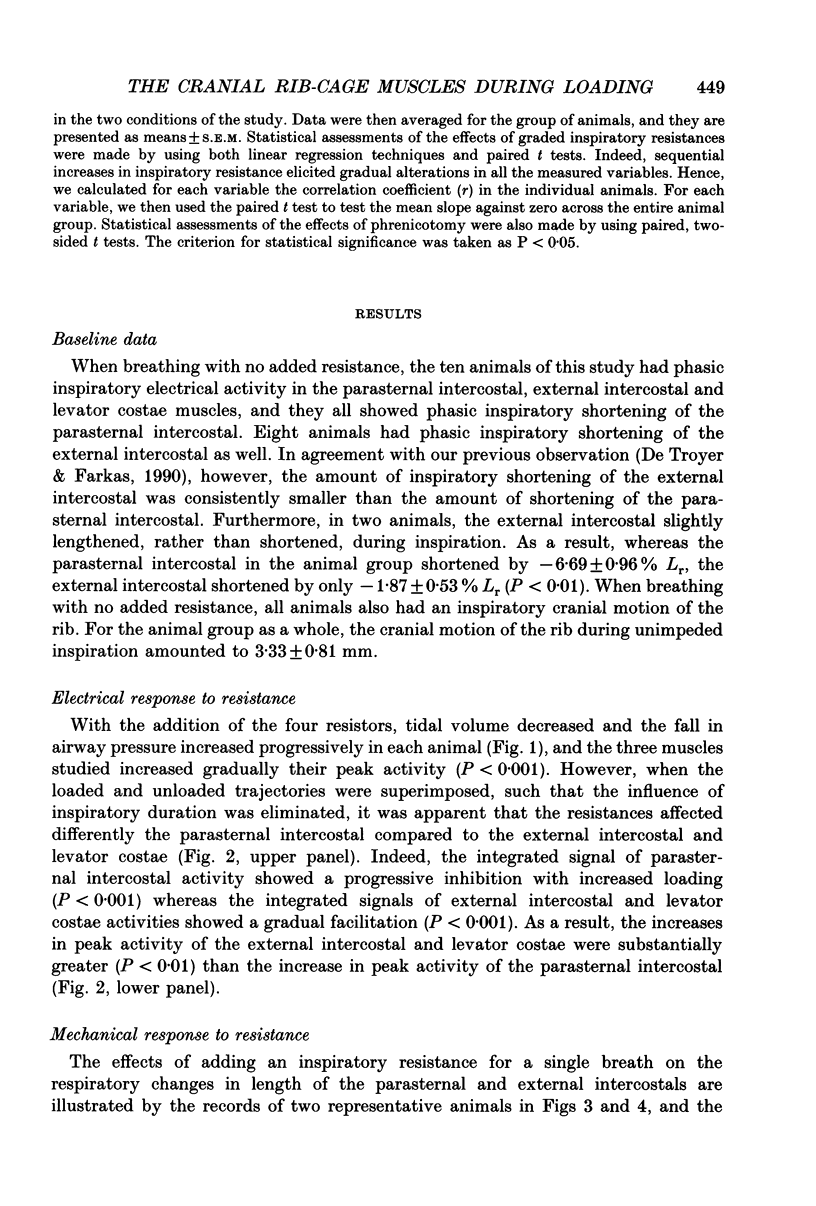





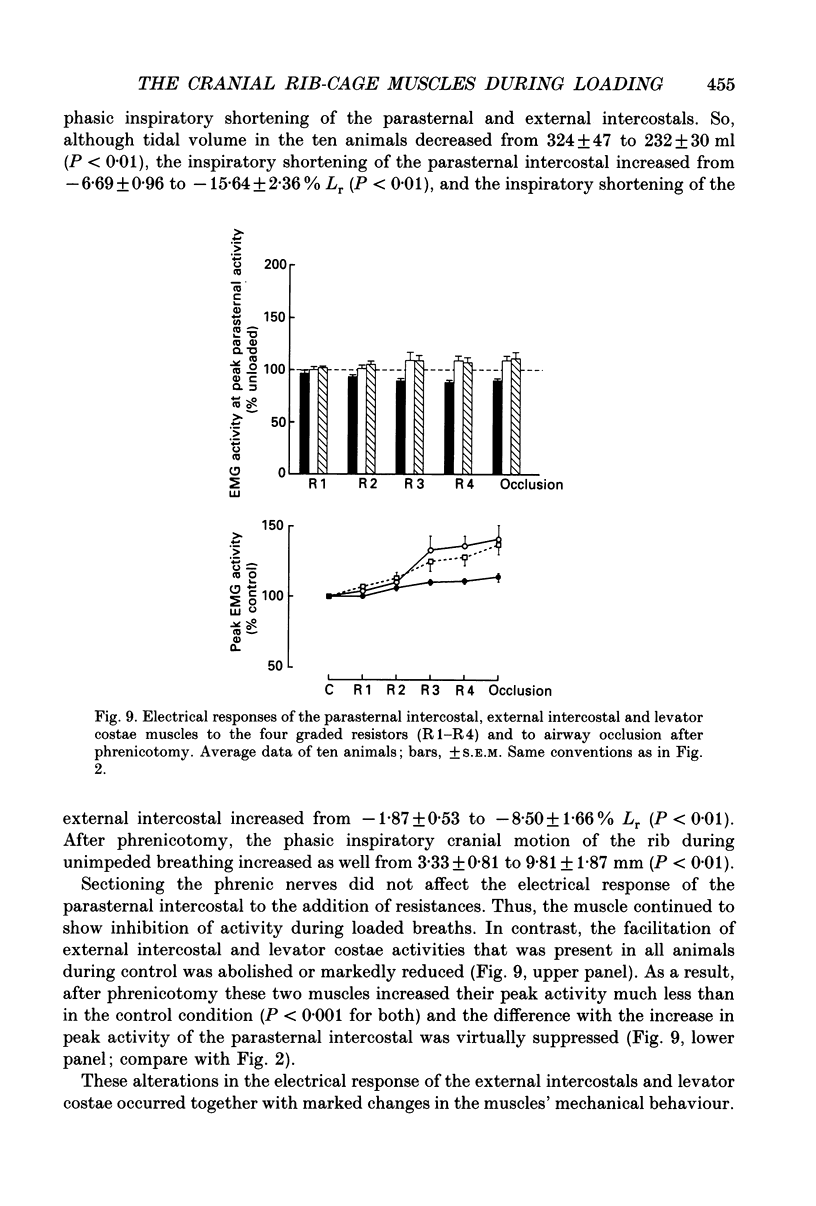



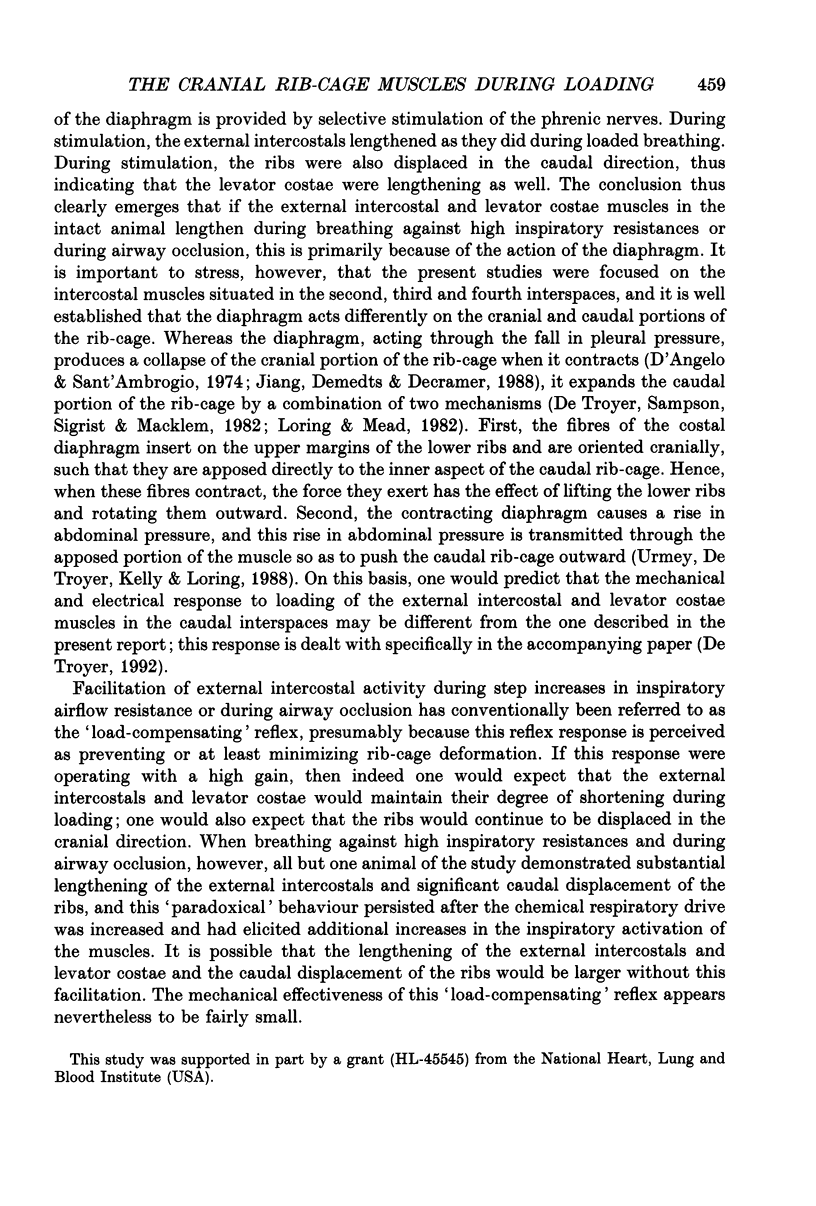
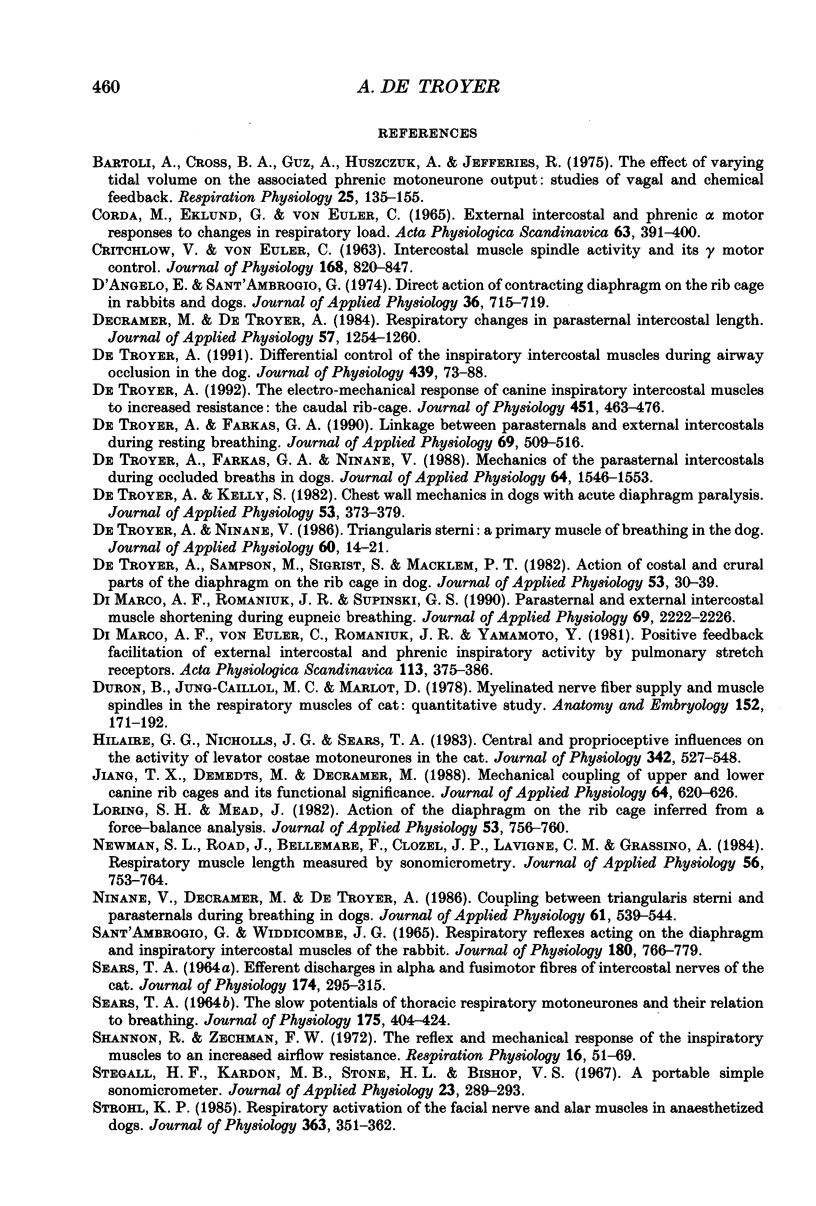

Selected References
These references are in PubMed. This may not be the complete list of references from this article.
- Bartoli A., Cross B. A., Guz A., Huszczuk A., Jeffries R. The effect of varying tidal volume on the associated phrenic motoneurone output:studies of vagal and chemical feedback. Respir Physiol. 1975 Nov;25(2):135–155. doi: 10.1016/0034-5687(75)90093-6. [DOI] [PubMed] [Google Scholar]
- CORDA M., EKLUND G., VON EULER EXTERNAL INTERCOSTAL AND PHRENIC ALPHA-MOTOR RESPONSES TO CHANGES IN RESPIRATORY LOAD. Acta Physiol Scand. 1965 Mar;63:391–400. doi: 10.1111/j.1748-1716.1965.tb04079.x. [DOI] [PubMed] [Google Scholar]
- CRITCHLOW V., VON EULER INTERCOSTAL MUSCLE SPINDLE ACTIVITY AND ITS GAMMA MOTOR CONTROL. J Physiol. 1963 Oct;168:820–847. doi: 10.1113/jphysiol.1963.sp007225. [DOI] [PMC free article] [PubMed] [Google Scholar]
- D'Angelo E., Sant'Ambrogio G. Direct action of contracting diaphragm on the rib cage in rabbits and dogs. J Appl Physiol. 1974 Jun;36(6):715–719. doi: 10.1152/jappl.1974.36.6.715. [DOI] [PubMed] [Google Scholar]
- De Troyer A. Differential control of the inspiratory intercostal muscles during airway occlusion in the dog. J Physiol. 1991 Aug;439:73–88. doi: 10.1113/jphysiol.1991.sp018657. [DOI] [PMC free article] [PubMed] [Google Scholar]
- De Troyer A., Farkas G. A. Linkage between parasternals and external intercostals during resting breathing. J Appl Physiol (1985) 1990 Aug;69(2):509–516. doi: 10.1152/jappl.1990.69.2.509. [DOI] [PubMed] [Google Scholar]
- De Troyer A., Farkas G. A., Ninane V. Mechanics of the parasternal intercostals during occluded breaths in dogs. J Appl Physiol (1985) 1988 Apr;64(4):1546–1553. doi: 10.1152/jappl.1988.64.4.1546. [DOI] [PubMed] [Google Scholar]
- De Troyer A., Kelly S. Chest wall mechanics in dogs with acute diaphragm paralysis. J Appl Physiol Respir Environ Exerc Physiol. 1982 Aug;53(2):373–379. doi: 10.1152/jappl.1982.53.2.373. [DOI] [PubMed] [Google Scholar]
- De Troyer A., Ninane V. Triangularis sterni: a primary muscle of breathing in the dog. J Appl Physiol (1985) 1986 Jan;60(1):14–21. doi: 10.1152/jappl.1986.60.1.14. [DOI] [PubMed] [Google Scholar]
- De Troyer A., Sampson M., Sigrist S., Macklem P. T. Action of costal and crural parts of the diaphragm on the rib cage in dog. J Appl Physiol Respir Environ Exerc Physiol. 1982 Jul;53(1):30–39. doi: 10.1152/jappl.1982.53.1.30. [DOI] [PubMed] [Google Scholar]
- De Troyer A. The electro-mechanical response of canine inspiratory intercostal muscles to increased resistance: the caudal rib-cage. J Physiol. 1992;451:463–476. doi: 10.1113/jphysiol.1992.sp019173. [DOI] [PMC free article] [PubMed] [Google Scholar]
- Decramer M., De Troyer A. Respiratory changes in parasternal intercostal length. J Appl Physiol Respir Environ Exerc Physiol. 1984 Oct;57(4):1254–1260. doi: 10.1152/jappl.1984.57.4.1254. [DOI] [PubMed] [Google Scholar]
- DiMarco A. F., Romaniuk J. R., Supinski G. S. Parasternal and external intercostal muscle shortening during eupneic breathing. J Appl Physiol (1985) 1990 Dec;69(6):2222–2226. doi: 10.1152/jappl.1990.69.6.2222. [DOI] [PubMed] [Google Scholar]
- DiMarco A. F., von Euler C., Romaniuk J. R., Yamamoto Y. Positive feedback facilitation of external intercostal and phrenic inspiratory activity by pulmonary stretch receptors. Acta Physiol Scand. 1981;113(3):375–386. doi: 10.1111/j.1748-1716.1981.tb06910.x. [DOI] [PubMed] [Google Scholar]
- Duron B., Jung-Caillol M. C., Marlot D. Myelinated nerve fiber supply and muscle spindles in the respiratory muscles of cat: quantitative study. Anat Embryol (Berl) 1978 Feb 20;152(2):171–192. doi: 10.1007/BF00315923. [DOI] [PubMed] [Google Scholar]
- Hilaire G. G., Nicholls J. G., Sears T. A. Central and proprioceptive influences on the activity of levator costae motoneurones in the cat. J Physiol. 1983 Sep;342:527–548. doi: 10.1113/jphysiol.1983.sp014867. [DOI] [PMC free article] [PubMed] [Google Scholar]
- Jiang T. X., Demedts M., Decramer M. Mechanical coupling of upper and lower canine rib cages and its functional significance. J Appl Physiol (1985) 1988 Feb;64(2):620–626. doi: 10.1152/jappl.1988.64.2.620. [DOI] [PubMed] [Google Scholar]
- Loring S. H., Mead J. Action of the diaphragm on the rib cage inferred from a force-balance analysis. J Appl Physiol Respir Environ Exerc Physiol. 1982 Sep;53(3):756–760. doi: 10.1152/jappl.1982.53.3.756. [DOI] [PubMed] [Google Scholar]
- Newman S., Road J., Bellemare F., Clozel J. P., Lavigne C. M., Grassino A. Respiratory muscle length measured by sonomicrometry. J Appl Physiol Respir Environ Exerc Physiol. 1984 Mar;56(3):753–764. doi: 10.1152/jappl.1984.56.3.753. [DOI] [PubMed] [Google Scholar]
- Ninane V., Decramer M., De Troyer A. Coupling between triangularis sterni and parasternals during breathing in dogs. J Appl Physiol (1985) 1986 Aug;61(2):539–544. doi: 10.1152/jappl.1986.61.2.539. [DOI] [PubMed] [Google Scholar]
- SEARS T. A. EFFERENT DISCHARGES IN ALPHA AND FUSIMOTOR FIBRES OF INTERCOSTAL NERVES OF THE CAT. J Physiol. 1964 Nov;174:295–315. doi: 10.1113/jphysiol.1964.sp007488. [DOI] [PMC free article] [PubMed] [Google Scholar]
- SEARS T. A. THE SLOW POTENTIALS OF THORACIC RESPIRATORY MOTONEURONES AND THEIR RELATION TO BREATHING. J Physiol. 1964 Dec;175:404–424. doi: 10.1113/jphysiol.1964.sp007524. [DOI] [PMC free article] [PubMed] [Google Scholar]
- Sant'Ambrogio G., Widdicombe J. G. Respiratory reflexes acting on the diaphragm and inspiratory intercostal muscle of the rabbit. J Physiol. 1965 Oct;180(4):766–779. doi: 10.1113/jphysiol.1965.sp007730. [DOI] [PMC free article] [PubMed] [Google Scholar]
- Shannon R., Zechman F. W. The reflex and mechanical response of the inspiratory muscles to an increased airflow resistance. Respir Physiol. 1972 Sep;16(1):51–69. doi: 10.1016/0034-5687(72)90088-6. [DOI] [PubMed] [Google Scholar]
- Stegall H. F., Kardon M. B., Stone H. L., Bishop V. S. A portable, simple sonomicrometer. J Appl Physiol. 1967 Aug;23(2):289–293. doi: 10.1152/jappl.1967.23.2.289. [DOI] [PubMed] [Google Scholar]
- Strohl K. P. Respiratory activation of the facial nerve and alar muscles in anaesthetized dogs. J Physiol. 1985 Jun;363:351–362. doi: 10.1113/jphysiol.1985.sp015715. [DOI] [PMC free article] [PubMed] [Google Scholar]
- Theroux P., Franklin D., Ross J., Jr, Kemper W. S. Regional myocardial function during acute coronary artery occlusion and its modification by pharmacologic agents in the dog. Circ Res. 1974 Dec;35(6):896–908. doi: 10.1161/01.res.35.6.896. [DOI] [PubMed] [Google Scholar]
- Urmey W. F., De Troyer A., Kelly K. B., Loring S. H. Pleural pressure increases during inspiration in the zone of apposition of diaphragm to rib cage. J Appl Physiol (1985) 1988 Nov;65(5):2207–2212. doi: 10.1152/jappl.1988.65.5.2207. [DOI] [PubMed] [Google Scholar]
- Younes M., Iscoe S., Milic-Emili J. A method for the assessment of phasic vagal influence on tidal volume. J Appl Physiol. 1975 Feb;38(2):335–343. doi: 10.1152/jappl.1975.38.2.335. [DOI] [PubMed] [Google Scholar]
- van Lunteren E., Cherniack N. S. Electrical and mechanical activity of respiratory muscles during hypercapnia. J Appl Physiol (1985) 1986 Aug;61(2):719–727. doi: 10.1152/jappl.1986.61.2.719. [DOI] [PubMed] [Google Scholar]
- van Lunteren E., Strohl K. P., Parker D. M., Bruce E. N., Van de Graaff W. B., Cherniack N. S. Phasic volume-related feedback on upper airway muscle activity. J Appl Physiol Respir Environ Exerc Physiol. 1984 Mar;56(3):730–736. doi: 10.1152/jappl.1984.56.3.730. [DOI] [PubMed] [Google Scholar]


